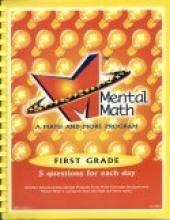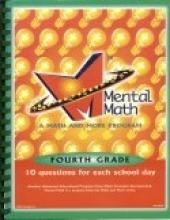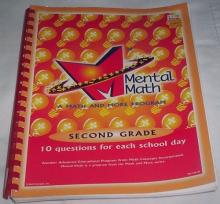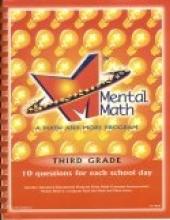Mental Math
Mental Math: First Grade
Problems at this level center around practice in the topics usually introduced at the 1st grade level. In the 5 questions for each day, concepts of numbers, computation, application, and mixed problems are covered. Sample questions chosen at random include the following: Write the number 203. What comes next: 50, 100, 150, ___ ? What month comes after March? A square has ___ sides. Jenny is six months old. Nicki is ten months old. Which one is almost one year old?
Mental Math: Fourth Grade
Problems at this level include a review of 3rd grade math and practice in the topics usually introduced at the 4th grade level. In the 10 questions for each day, concepts of numbers, computation, application, and mixed practice are covered. Sample questions chosen at random include the following: Increase the tens place by one in the number 23,460. What is the area of a square that is 4 feet on a side? What number when multiplied by two becomes 22? AZ, AY, AX, ____. What comes next? If I put five red marbles and one green marble in a bag, what are my chances of picking a red marble? Write it as a ratio.
Mental Math: Second Grade
This Math supplement provides 10 questions (which should take approximately 7 to 10 minutes) each day which are read aloud by the parent/teacher and computed mentally by the student who writes only the answer on paper. The questions should be helpful in introducing students to the language and vocabulary used on standardized tests, gaining confidence and practice in mental computation and allows the parent/teacher to quickly (and regularly) evaluate the student's progress (this might be especially useful for students who do much of their Math work independently). We also found that these problems make a good opportunity for working on following directions.
This second grade book begins with 15 review lessons of five problems each. The students then begin sets of the normal 10 problems which cover material such as writing numbers in standard or expanded form, determining the next number in a pattern, values of greater than or less than, and determining whether a number is even or odd. Later problems in this volume involve simple computation (addition and subtraction), money and time problems, days of the week, months of the year, simple fractions and place value. The answer is included in parentheses after each problem. Also included in the book are an extensive glossary and ideas for implementing a incentive/reward system (probably more appropriate for the classroom than a homeschool situation).
We've used this book for several months and I've found it to be a helpful supplement for my second grade daughter. Because of it's simplicity, it would also make a good choice for those who homeschool "part-time" (i.e.supplement their child's education at home).
Sample problems (selected from throughout the book) include: Write the number 214 in expanded form. What comes next 33, 36, 39, _ ? What digit is in the ones place in the number 34? Write the number that has five hundreds, six tens and three ones. Decrease the tens place by one in the number 58. Is the number eight even or odd? Is the number 47 about 50 or about 40? Which is more: 301 or 311? Draw a circle. Shade one half of it. Which is less: two tens or three tens? Which is more: three dimes or one quarter?
Mental Math: Third Grade
Problems at this level include a review of 2nd grade math and practice in the topics usually introduced at the 3rd grade level. In the 10 questions for each day, concepts of numbers, computation, application, and mixed practice are covered. Sample questions chosen at random include the following: Draw six circles and shade one-third of the set. Estimate the answer: 490 + 180 is about how much? It is one hour earlier in Chicago than here. Look at the clock and write down the time that it is in Chicago now. What comes next: A1, B2, C3, ___ ? 13,900 - 1,000 = ?




